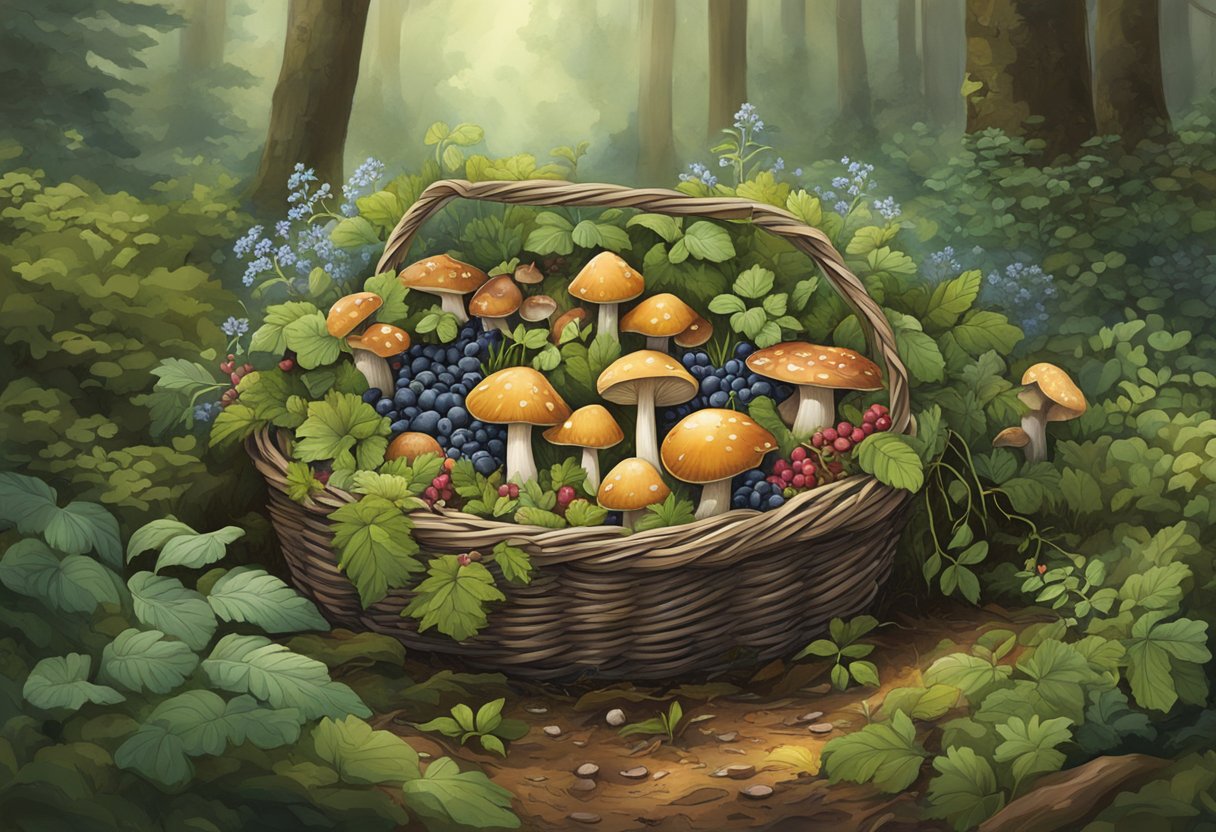Foraging has seen a resurgence in recent years, appealing to those interested in sustainable living, natural foods, or simply the joy of connecting with nature. An essential tool for any forager is a dependable foraging basket. A well-chosen basket not only serves as a container for wild edibles but also plays a crucial role in the foraging process by protecting delicate specimens from damage, allowing for easy transport, and even contributing to the proper identification and sorting of found items.

A foraging basket is more than just a receptacle; it’s a companion on your journey through nature’s abundance. It should be lightweight yet sturdy enough to handle various terrains and weather conditions. With many options available, from woven willow baskets to modern, durable bags, there is a basket to suit every forager’s needs. Comfort, capacity, and ease of access are key attributes to consider, ensuring you have a successful and enjoyable foraging experience.
Key Takeaways
- A foraging basket is a vital tool for collecting and protecting wild edibles.
- Choice of basket should factor in durability, comfort, and suitability for the terrain.
- Efficient design contributes to the forager’s overall experience and success.
Essentials of Foraging Baskets
When selecting a foraging basket, consider its design and quality. A reliable foraging basket can make your harvesting experience more productive and enjoyable by properly accommodating your findings.
Materials:
- Wicker: Traditional, allows airflow, but not water-resistant.
- Canvas: Flexible and strong for varied terrain.
- Leather: High durability, aesthetic appeal.
- Mesh bag/Nylon: Lightweight, good for ventilation.
Construction: Look for a durable build that can withstand nature’s elements and the repeated wear of outdoor adventures. Checks for signs of sturdy construction in all parts, from the base to the handles.
Design Features:
- Compartments: For organizing different types of forage.
- Pockets: For quick access to tools like a knife or gardening shears.
- Weight distribution: Ideally, your basket should be designed to minimize strain.
Types of Foraging Containers:
- Foraging Bag: Flexible, often with shoulder straps, suited for long walks.
- Backpack: Frees your hands for picking, but may not be as accessible.
- Pouch: Convenient for a small harvest, can be hung from a belt.
| Material | Benefits | Considerations |
|---|---|---|
| Wicker | Breathable, Classic | Not water-resistant |
| Canvas | Durable, Versatile | Heavier |
| Leather | Durable, Stylish | Requires care |
| Mesh/Nylon | Lightweight | Less protection |
Select your foraging container based on the environment you’ll be in and the type of foraging you plan to do. Your foraging experience will be more rewarding with the right basket that fits your approach and needs.
Considerations and Accessories for Foraging

When it comes to foraging for wild food such as mushrooms, berries, and nuts, the right accessories, including a selection of baskets and tools, can make a significant difference. Durability, convenience, and proper tools are central to a successful foraging trip.
Choosing the Right Basket for Different Foraging Needs
Selecting a basket that matches your specific needs is crucial. Compact canvas bags like the Gootium High-Density Canvas Bag are ideal for short forays, while the AuSable basket caters to those needing more space and airflow for items like fruits and vegetables. If you’re foraging for mushrooms, consider a basket with a wider weave to allow spores to disperse, like the My Lucky Shrooming Bag.
Foraging Basket Enhancements
Enhancements can include features such as waterproof linings or additional compartments for separating different finds. A vintage bag from Etsy might offer a unique design with special compartments, while the Barebones Harvesting and Gathering Bag comes with convertible straps for ease of carrying.
Foraging in Style and Sustainability
For a stylish approach that doesn’t compromise the environment, look for sellers like Hide & Drink, offering handcrafted leather accessories. Sustainable materials are not only eco-friendly but often provide lasting durability, meshing well with conservation efforts in foraging.
Practical Foraging Tips and Tools
Equip yourself with practical tools such as lightweight pruning shears, a reliable field guide for identifying wild edibles, and durable gloves. A leather Hide & Drink tool roll can keep your knives and tools safe and organized. In addition, carrying your phone in a secure pocket allows for quick reference or GPS usage.
Privacy and Online Shopping Insights
Understand that online shopping might require passing a CAPTCHA, managing browser cookies, and dealing with ad blockers. Always shop for foraging gear with discretion, providing your email address only to trusted sites for newsletters and exclusive offers.
Foraging Ethics and Conservation
It’s fundamental to forage with conservation in mind. Respect the mycelium and spores, allowing mushrooms to reproduce. Be aware of your impact on wildlife habitats and adhere to ethical guidelines to ensure that wild edibles continue to thrive.
Durability and Maintenance
Any foraging basket or bag like the durable Gootium Canvas Bag should withstand frequent use and exposure to the elements. Regular maintenance, such as cleaning and checking for wear and tear, ensures the longevity of your foraging gear.
Carrying Convenience
For hands-free convenience, a basket or bag with straps that distribute weight evenly, or a frame pack, is ideal. Products like Morel Mushroom Store’s frame pack offer such benefits, along with features like a drawstring to secure your finds safely inside.
Frequently Asked Questions

Selecting the right foraging basket depends on understanding the materials, size, features, and even how to make your own. These FAQs will guide you through making the best choice for your foraging needs.
What materials are best for a durable foraging basket?
For a basket that can withstand the elements and wear from outdoor use, look towards materials like woven willows or sturdy fibers. Barebones Harvesting and Gathering Bag is an excellent example of a durable option crafted for all types of weather.
How do I choose the right size for a mushroom foraging basket?
The right size for a mushroom foraging basket balances ample space for your finds with ease of carrying. Consider a size that fits comfortably in your hand and has enough volume to hold the mushrooms without crushing them. Mesh bags can be a good choice due to their flexibility and breathability.
What are the advantages of a foraging basket with a strap?
A strap adds comfort and convenience, allowing you to forage hands-free and distribute the basket’s weight more evenly. This is crucial for long treks or if you’re navigating uneven terrain where you need to maintain balance.
Can you provide steps for making a DIY foraging basket?
Begin by selecting flexible materials like willow or vine for weaving your basket. Shape the base, form the stakes, and weave the sides in an over-and-under pattern. Attaching a handle or strap will make carrying easier. For a more structured guide, there are resources online showing detailed steps.
Which features make a foraging basket suitable for different terrains?
Look for features such as a waterproof lining for wet conditions and a sturdy base for rocky terrain. Baskets like the Orsus Workshop Foraging Mesh Basket offer vine hoops and handles that are easy to manage across various terrains.
What are some recommended foraging baskets for beginners?
For beginners, opt for baskets that are lightweight yet robust, like the mesh bag or a simple woven basket. They should be easy to carry and clean, helping you focus on the experience of foraging itself, rather than managing unwieldy equipment.


